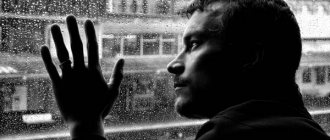“I’m not against shopping and meeting friends, but lately I hardly leave the house. I prefer to get to work by taxi - it’s faster and safer. Minibuses, metro and noisy crowds - all this is a thing of the past and, apparently, forever. I won’t be able to become a normal person anymore.”
Interestingly, there are more and more similar messages on forums. Why, living in such a civilized century with high technology and excellent doctors, are people increasingly afraid of each other and seriously experience suffocation and tachycardia in public places? The most frequent victims and hostages of their fear are, of course, VSD soldiers. After all, they are endowed with a special nervous system in which phobias feel comfortable, like fish in a pond. Is the situation really hopeless?
Panic attacks
Based on the theory of the development of fear of going outside on your own, there are two directions:
- Proponents of this view think that agoraphobia has a primary fear of helplessness in the face of large spaces that causes attacks.
- Followers of the second idea are confident that the basis of the pathology is a panic attack, formed into a phobia. The fears experienced reinforce and strengthen the primary branch, paralyzing the will, and provoking attacks.
Panic attacks occur spontaneously, a person is afraid to go outside, he does not understand what to do, reinforcing the real danger many times over with the subconscious. Fear of death or madness occurs. A type of attack similar to a vegetative crisis is characterized by the appearance of anxiety and pain of a different nature.
If reality becomes blurred, the client panics, becomes hysterical, screams, and asks for help. In severe cases, seizures occur. The duration of the unconscious process is about 15 minutes, less often half an hour. Attacks are more typical for suspicious people.
Fear of going outside - what is the name of the phobia?
This phenomenon was first mentioned by Karl Westphal at the end of the 19th century. A German psychiatrist described the state as panic when required to contact a crowd or be in an open, uncontrolled space. The word agoraphobia comes from the Greek "agora" and "phobia", which means public place and fear.
In fact, the fear of leaving the house is an unconscious defense mechanism formed in front of unfamiliar places and people. The symptom has a basis - emotional trauma. The panic type occurs when the client gets to the place where he previously experienced an attack.
By the way, until the end of the 20th century, most psychiatrists were sure that the fear of going outside was only a symptom of anxiety. But gradually the phenomenon was identified as a separate disease.
Reasons for developing a fear of going outside
- Heredity
. Quite a large number of specialists in the field of psychiatry are confident that all neuroses should be considered exclusively at the genetic level of manifestation of a certain pathology. Based on the results of their research, it can be concluded that a fifth of the population who are afraid to go outside borrowed a similar model of behavior from their parents. Sometimes a “gift of fate” can even be passed down from grandparents. - Increased anxiety
. People with an overly excitable psyche are afraid of everything, even their own shadow. For them, leaving the house is a feat that they are not going to accomplish. If we make an analogy with animals, then a person of this type automatically turns into a turtle, which is securely hidden in its shell. - Diffidence
. People whose complexes play a dominant role over other priorities try not to leave their native walls again. In every glance of a passerby, they see disapproval and even censure, which puts such poor fellows into a stupor and even depression. This is often encountered by young mothers after childbirth, and women in adulthood who find it difficult to control their weight. People with a pronounced defect in appearance (large birthmarks, growths on the body, etc.) are also susceptible to fear. - Disability
. People with disabilities often try to isolate themselves within four walls, because this is where they feel safe. For them, the street is a high-risk zone, even if they live in a quiet rural area. - Dysfunction of mental regulation
. In some anxious individuals, biological processes in the brain malfunction. In this case, there is an imbalance of reflex functions that must be controlled by consciousness. - Expansion of the stressful situation
. A child’s fear of entering a dark room can later develop into a much more serious phobia. The expression “my home is my castle” is also beginning to be perceived by some people as an unconditional verdict. - Low social status
. In this case, we are not talking about embarrassment and fear of becoming a laughing stock in the eyes of more successful people. A person who is afraid to leave home, in most cases, simply does not want to see a higher standard of living in the society that surrounds him. It’s easier for him to close himself in “his own box” so as not to correct anything and not fight to change the situation. - An accident that occurred
. If the poor fellow became a hostage in the past or observed some kind of disaster, then he will not have the desire to go out into the street again. After suffering stress, such people become hermit crabs who feel quite comfortable in such a situation. - Definite addiction
. In this case, we are not talking about alcoholics who, in the cold and cold, will leave the house in search of a strong drink. Those same computer gamers are so oblivious to reality that even a trip to the nearest bakery seems like a feat to them. - Accompanying effect
. Some phobias in humans tend to intertwine quite harmoniously with each other. Against the background of one mental pathology, another emotional anomaly is quite capable of developing, which leads to a fear of going out. - Fear of death
. Every adequate person does not want to say goodbye to his life before the scheduled date. However, in some cases, such a desire turns into a certain mania. People who fear death every second are simply trying to make a fortress out of their home. For them, going outside is equivalent to a death sentence for themselves. - Internal dictate
. Very often, parents prohibit young children from communicating with their peers outside the walls of the house, scaring them at the same time and inventing all sorts of horror stories. After personality maturation, mature adolescents may then perceive the street solely as a threatening factor.
How to deal with the fact that the lock is constantly being cut down
It is clear that according to the law, the Criminal Code bears responsibility for locked doors to the roof. Its employees must constantly check whether the locks on the doors leading to the basements and to the roof of the apartment building are locked.
But there are times when the roof of a house is especially attractive. It offers a beautiful view that attracts couples, or because of its convenient location, it has become a meeting place for young people who prefer to drink alcohol and smoke away from prying eyes. Then no matter how much the Criminal Code puts up new locks, they are cut down and broken into again.
The solution may be to install an alarm. Then, if there is a break-in attempt, security will come to the site (you will need to enter into an agreement with a private security company). Bullies will be caught and held accountable, and others will be disgraced.
Manifestations of agoraphobia - fear of open places, fear of going outside
The main, leading symptom of agoraphobia is the fear of open spaces, the fear of going outside, the fear of entering large rooms (halls, recreation rooms, long corridors, rooms with high ceilings, etc.). Agoraphobia can manifest itself in the form of a variety of symptoms, which can manifest itself in the form of: - uncontrollable, unclear fear; - in the form of suffocation, palpitations, a lump in the throat and other somatic phenomena; - weakness in the legs or throughout the body; - internal trembling; - increased sweating, feeling hot, feeling cold
However, most often agoraphobia is accompanied by several symptoms at the same time, which can be combined into one well-known term - panic attack. Therefore, doctors most often treat agoraphobia with panic attacks.
Phobias are obsessive fears. Phobic anxiety Feelings of fear in open places or on the street Fear of leaving the house alone Fear of riding in public transport Need to avoid certain places or activities Fear of fainting
Characteristic symptoms
What is characteristic of agoraphobia is that the person suffering from it worries in advance and experiences panic even at the prospect of a simple trip to the store
Signs, manifestations and symptoms of agoraphobia are panic attacks. They are paroxysmal in nature and can last from several minutes to half an hour. At this moment, a sudden release of adrenaline occurs in the body, which provokes the following physiological reactions:
- increased blood pressure;
- feeling your own heartbeat;
- lack of air;
- increase in heart rate above 100 beats per minute;
- disorientation in space;
- dizziness;
- increased muscle tone;
- profuse sweating.
Often the attack is accompanied by pale skin, tremors of the hands, and cold sweat. Panic attacks with agoraphobia are manifested by the following mental reactions:
- confusion;
- sudden fear of death;
- growing panic;
- all-consuming fear;
- loss of control over one's own emotions.
The person is not aware of what is happening during an attack. In severe cases, the patient may try to run away, hide, or simply quickly leave the place in which panic overtook him. The fear of death during an attack is explained by the somatic manifestations of the phobia - a strong heartbeat and a sudden jump in blood pressure.
If agoraphobia occurs without panic attacks, the symptoms are more subdued. A person feels anxiety and irrational fear, blood pressure may rise and dizziness and confusion may appear.
The fear of open spaces visits a person to a greater extent in unfamiliar places. The problem is aggravated by the fact that over time the fear of a new attack develops, as a result the patient has to consciously avoid situations that repeat those in which the panic attack began.
Main signs of street fear
The fear of going outside is reflected by the following signs:
- Anxiety. As the disease progresses, fears take on new colors; the client is even afraid of what is happening in his thoughts. He invents many scenarios and plots of events for himself, driving himself deeper into his own cage of hopelessness.
- Cardiopalmus. A panic attack feels like a claustrophobic attack. The client panics, loses his bearings, sweats, his heart rate increases, and it becomes difficult to breathe. This condition occurs when the home is abandoned and there is unprotected space around.
- Difficulty breathing. Characteristic of panic attacks. Violation of the correct rhythm leads to panic of a hypochondriacal nature. The person is afraid of suffocating and loses control.
- Weakness of muscle structures. Occurs during prolonged emotional stress. Apathy begins, the person loses strength, he ceases to be interested in what is happening around him.
- Nausea. This symptom clearly shows disgust, rejection of life. Tablets are powerless. The condition normalizes on its own after treatment of the underlying cause.
- Obsession. The slightest problem becomes an insoluble tragedy. The client considers himself a failure, a leper.
- Feeling hot. At the moment of panic, the face turns purple, a surge of warmth is felt, blood pressure and pulse rise. Against this background, noise is heard, ringing in the ears, sweat appears.
- Pre-fainting state. Severe dizziness can cause fainting.
- Cramps. When there is strong fear and panic, a person begins to shake when going outside, and short-term convulsions occur.
- Losing your bearings. The client does not remember where he came from, does not understand which direction to move in order to find protection.
- Stomach upset. It may manifest as diarrhea or, conversely, constipation. It occurs due to stress.
The fear of going out is psychologically manifested by the fear of having an attack in public, losing your mind, losing control, depression, constant obsessive anxiety, and low self-esteem.
Causes
The predisposition to form illogical fears is passed on from ancestors to descendants. In the family history of sick people, as a rule, cases of phobic anxiety disorders are recorded. However, unfavorable heredity acts only as a background; the disorder itself develops under the influence of other internal and external factors.
Certain character traits and personal qualities are fertile ground for the emergence of irrational fear. Suspicious, impressionable, and easily vulnerable people are more susceptible to uncontrollable anxiety. Such people have a tendency towards perfectionism and pedantry: they are demanding of themselves, striving to complete all tasks in an ideal way. Most people with this problem tend to fixate on small details; they constantly analyze their actions and think overly carefully about possible solutions. They are responsible and disciplined. They prefer to rely on reason and never act based on a momentary impulse.
According to the stories of some people, the first episode of panic fear occurred after suffering a traumatic situation. The fear of leaving the house arose after a person became a participant or witness to hooliganism, riots, terrorist attacks, or accidents. The fear of leaving home developed if a person suffered physical or sexual violence on the street, or experienced emotional trauma when communicating with people.
At the same time, a psychotraumatic situation leads to disastrous consequences if the individual lacks the resources to adapt and resist stress factors. A deficiency of protective reserves occurs with severe mental fatigue, physical fatigue, lack of adequate leisure, and regular lack of sleep. The culprits for the deterioration of the body’s adaptive capabilities are: alcohol abuse, drug use, uncontrolled “hobby” with medications. The background for failures in defense mechanisms is chronic somatic ailments and diseases of the central nervous system.
In some cases, an irrational fear of going outside the home has no obvious reason in the person's personal history. The fear of leaving the premises arises due to unresolved internal conflicts formed in the distant past. At the same time, the individual does not realize and does not understand, and sometimes cannot even remember when the problem began to swirl.
Treatment of pathology
Before prescribing treatment, the patient must visit specialized specialists (general practitioner, cardiologist, psychiatrist, neurologist), who will rule out diseases with similar symptoms.
To get a complete picture of the disease, psychiatrists usually use a number of tests: anxiety scales and panic attack assessments, Beck Depression Test.
Drug treatment consists of selecting antidepressants, tranquilizers and antipsychotics that correspond to the severity of the disease. Along with medications, psychotherapeutic sessions are conducted with the patient (Ericksonian hypnosis, cognitive behavioral therapy, Gestalt therapy, etc.).
In addition, the patient is recommended to use relaxing techniques at home (breathing techniques, muscle relaxation exercises, meditative practices, art therapy, etc.), which can be studied in specialized literature or via the Internet, for example, in a video blog
What else would I like to say?
Issues related to the safety of children should always come first, so choose a management organization carefully. Its employees must ensure that the exit to the roof is always closed. But check yourself from time to time to see if the lock is hanging if you live on the top floor.
Don't pass by if you see children walking on the roof - there are no other people's children. Explain to your children why climbing on the roof is not at all cool and what walking on it can lead to.
Treatment of agoraphobia
When there is a fear of leaving the house, each case requires an individual approach, drawing up a treatment regimen. Apply:
- Drug treatment. Helps to temporarily stabilize the emotional state so that he can overcome the disease.
- Psychotherapy. It can be individual or group. Helps to stabilize the mental background, identify the problem, and learn to look at the current situation from the other side.
- Hypnosis. Used to identify the cause of the development of a phobia, if this cannot be done by other methods. Also, with the help of hypnosis, a specialist can give the necessary commands to correct the client’s behavior.
Methods to combat phobias
The phrase I'm afraid to go outside speaks of an internal personality conflict. To get rid of this condition, you should distract yourself:
- shopping. Purchasing things relaxes and gives a lot of positive emotions;
- buying a dog. You need to walk the animal, which will force you to leave your home;
- chat with friends. A meeting of relatives is arranged near any convenient area except home;
- picnic. Fresh air, loved ones, relatives will help you cope with the problem;
- child therapy. Little toddlers are full of energy and cheerfulness. Therefore, communication brings pleasure and helps to find meaning in life.
Self-help for agoraphobe
There are a number of simple exercises that you can do if the answer to the question “am I afraid to go outside because of panic attacks” is yes.
- After taking the medicine prescribed by a specialist, you need to turn on calm music and try to relax as much as possible - after ten to fifteen minutes, you can start imagining with your eyes closed how you leave the threshold of the house. There is no need to rush: if there is any inconvenience within your visualization, you should immediately return home. With each repetition of the exercise, you need to gradually extend the time spent above the threshold, and then the distance. Once you get used to the sensations, you can experiment with distance from home and the time of imaginary walks.
- It is necessary to find a point inside the house to which feelings of comfort are attached. This should not be some place, but a point - on the wall, chest of drawers or the back of a chair. In your imagination, you need to learn to materialize this point and move it in space (at the initial stage within the home), without losing the feeling of comfort and confidence in safety.
These exercises can help get rid of agoraphobia during panic attacks, but provided that the situation is not too advanced and the disease is not complicated by a number of concomitant phobias.
Ways to cope with fear on your own
Most often, clients ask the psychologist the following questions: why they are afraid to go out, what is the name of the disease, are there ways to solve the problem on their own. Better at the time of attack:
- Calm down, look at the potential threat as an outside spectator.
- Be close to your loved one. This will help you gain confidence.
- Try to get distracted and talk to people.
- Normalize breathing. Taking a deep breath and exhaling the same way relaxes the muscles and calms you down.
When the fear of leaving the house is strong, then training begins in a comfortable place. Having taken the necessary medications, you should mentally leave your home step by step. When you feel an attack approaching, you should calmly return home. Daily activities gradually expand the permissible territory, the person decides to take a real action.
Treatment of agoraphobia with panic attacks
A feeling of fear in open places or on the street is a problem associated with a mental state disorder and cannot be controlled by the efforts of one’s own will; it requires the mandatory participation of a medical professional with higher medical education, a psychiatrist or psychotherapist.
Agoraphobia with panic attacks can be treated using complex techniques from a psychotherapist. Active neurometabolic therapy, psychotherapy are used, physiotherapeutic procedures are often prescribed, and a daily routine and diet are selected.
Treatment of agoraphobia with panic attacks is selected only individually, only after a thorough examination and identification of the true causes of the formation of a violation of the biological processes of the brain. It is not the symptoms that are felt by the person that are treated, but the cause that the person does not feel. The true reason is sometimes very well hidden from the eyes of non-specialists, and even more so from the person who suffers from it. Treatment of agoraphobia and panic attacks by psychologists or ordinary psychotherapists, without higher medical education and education in psychiatry, should be categorically excluded.
Prognosis for treatment of agoraphobia with panic attacks
Agoraphobia with panic attacks is treatable and the prognosis, as a rule, is favorable with proper treatment and following all the instructions of the attending physician.
If there is no treatment or incorrect treatment, the prognosis is usually not favorable.
Call
We can help you.
Principles of treatment
The tablets are taken regardless of meals, washed down with a sufficient amount of drinking water; the duration of therapy and dose are determined by the doctor individually for each patient
How agoraphobia should be treated depends on the specific symptoms observed in each case. Your doctor may suggest drug therapy or behavioral intervention, or a combination of both. Drug treatment is prescribed only if the phobia manifests itself as severe panic attacks.
If agoraphobia is manifested by a desire to quickly leave a place in which a person feels uncomfortable, severe discomfort when being in unfamiliar places, as well as the need to stay in a “comfort zone,” drug therapy is not needed.
Professional help
How you can get rid of agoraphobia in each specific case is decided by the doctor after a conversation with the patient. Therapy and treatment of agoraphobia complicated by panic attacks begins with drug correction. For this purpose, tranquilizers (Diazepam), antipsychotics, drugs for the treatment of neurosis, and antidepressants are prescribed.
After reducing general nervousness, they move on to behavioral therapy. Methods are selected individually for each person. For agoraphobia use:
- cognitive psychotherapy;
- implosion therapy;
- hypnosis.
Cognitive psychotherapy helps both overcome agoraphobia and learn to control your thinking in general. It involves eliminating inappropriate thoughts and misperceptions of situations in which the phobia worsens.
Implosive therapy involves identifying all existing fears and gradually working through them. The doctor and the patient make a list of situations in which an attack begins, ranking them in order of decreasing symptoms. So, for example, if being in the square causes a panic attack and loss of control, this item is first on the list. Open doors and windows, which only cause irritation and a desire to close them as quickly as possible, will then be at the bottom of the list. Then the patient, alone or together with the doctor, begins to consciously seek encounters with frightening situations, starting from the end of the list. So, in this example, the first thing the patient will face is an open door, but will refrain from immediate action. So, gradually moving through the list, a person gets used to fighting his fears.
Implosive therapy is very effective for agoraphobia, but it cannot be carried out without preparation; first it is necessary to normalize the psycho-emotional state of the patient.
Hypnosis can help, but a long course of such procedures is required to achieve results.
Self help
Agoraphobia can be successfully treated if a person consults a specialist in a timely manner
Having figured out how to cure agoraphobia with the help of a doctor, you should know how you can treat the disorder yourself. Self-medication is permissible only in cases of moderate anxiety and the absence of panic attacks. Otherwise, special medications are needed that are not available without a prescription.
You can deal with the problem yourself using implosive psychotherapy. Here it is recommended to enlist the help of a loved one who will help you quickly leave the place that provokes the onset of the attack.
In general, phobia of unfamiliar places, or fear of open space, can be successfully treated if a person consults a specialist in a timely manner. In advanced cases, such a phobic disorder leads to severe neurosis and depression.
What is agoraphobia
When a patient turns to a specialist with the problem “I’m afraid to go outside because of panic attacks,” we can talk about the development of agoraphobia.
Agoraphobia is essentially a term that unites specific isolated fears that are interconnected in essence. Thus, denoting a fear of open space, agoraphobia can often coexist with a fear of public speaking, and sometimes with social phobia.
Agoraphobia is usually called fear that appears accompanied by vivid clinical manifestations of a somatic nature that arise in certain places or circumstances:
in open areas; in public areas, in places with large concentrations of people (cafes, shopping centers, metro); at large-scale cultural events (concerts, fairs, sports competitions); when there is a likelihood of attracting the focused attention of strangers; if the door and window openings in the room are open; in deserted places where there is no opportunity to seek help; when moving alone; in the absence of an accessible opportunity to return to a comfortable place at any time, which most often is home for the patient.
Agoraphobia can also arise as a defense mechanism against the present fear of encountering aggressive behavior from others, fear of public shame and criticism from strangers, as well as uncertainty about the compliance of one’s own behavior with the norms of public morality.
Where does fear and fear of the street manifest itself?
Most often, agoraphobia occurs:
- at a bus stop when there are a lot of people;
- near train stations, airports;
- if necessary, leave the house alone, on a deserted street;
- in public, before or during a performance;
- if there are unpleasant personalities around who can negatively evaluate the client’s actions;
- when there is no way to defend yourself, leave the unfavorable area quickly.
If a loved one is close to the person, then panic attacks do not occur.
The main signs of a person’s fear of going outside
- Increased heart rate
. At any prospect of leaving their native walls, a person with the stated problem begins to beat actively. At the same time, the pulse goes off scale so much that in some cases you can call an ambulance. - Feeling hot
. We can all blush when we are given a well-placed compliment or simply flattered. However, for people with a fear of going outside, such a phobia takes on such global proportions that the poor fellow’s face turns purple in a matter of minutes. - Change in blood pressure
. Hypotonic and hypertensive patients with pronounced pathology react especially aggressively to the need to go outside against their wishes. However, people who do not suffer from unstable blood pressure may also experience similar problems in the early stages of agoraphobia. - Weakness in the legs
. They don’t hold us back not only during drunken fun, but also for other reasons. Beginning agoraphobes, even when leaving their home, understand that they simply are not able to take a step beyond the threshold of their home. - Loss of orientation
. Some people will look for a way in a labyrinth that consists of three pines if they had to leave their home walls. They literally will not be able to understand where to go and what is happening around them in this situation. - Refusal to communicate with friends
. In this case, we are not talking about alienating friends from oneself in the literal sense of the word. On his territory, such a person is ready to meet anyone, but you should forget about gatherings in any bar or restaurant in his company once and for all. - Panic attack
. When it comes to such a phenomenon, it is worth ringing all the bells when a problem arises. A person who is adequate in his actions should not be frightened by the prospect of leaving his home. Otherwise, a person who decides to live in an artificially created bunker should be treated by a psychotherapist.
The first fear is the main anchor
The complexity of a phobia is that even an experienced psychotherapist is not always able to discern where the roots of the problem lead. But when it comes to VSD sufferers, then in the overwhelming majority of cases the trigger is the most common panic attack, which for certain reasons did not occur at home at the usual time, but in public. And it was a real nightmare: there were no household members or a life-saving first aid kit nearby, everything around was unusual, and most importantly, there was a clear realization - this is how I will die among these strangers, no one will help me, they will only discuss and laugh.
The subconscious mind remembered this panicky conclusion and decided that a public place or just a street was a deadly place. This is how the main anchor appeared. As soon as you move it, the clear bottom of the soul becomes cloudy and frightening. Having returned to this place again, the VSD student will subconsciously understand: death is somewhere nearby. And nature, which protects its creatures, will never allow this stupid death. Adrenaline will immediately begin to release, the heart will pound furiously, and the person will feel the rush of insane panic. It’s as if the body itself is screaming at him: run away, run before it’s too late!
Having succumbed to his fear several times, the VSD worker tightens his anchor more and more, and one day he realizes: the fear of leaving the house has become so strong that, perhaps, it will soon leave him without friends, travel and a job.
There are other causes of agoraphobia that do not depend on whether a person has VSD. These include hereditary factors, childhood psychological trauma, the effects of taking certain medications, and even a person’s specific personality type. But whatever the reason, is there a chance to independently eradicate this terrible phobia that has narrowed your life to the size of an apartment?
Development mechanism
As a rule, it all begins with a panic attack that appears in a characteristic situation, and therefore the connection “leaving the house – danger” is formed in the subconscious. As a result, fearing that panic attacks will overtake him again on the street, a person tries to eliminate risk situations from life: limiting himself in movement and communication.
At moments when the patient is forced to leave a comfortable environment, he involuntarily exhibits somatic signs of anxiety:
- cold sweat;
- increased heart rate;
- severe nausea;
- dry mouth;
- lack of air;
- pain in the heart area;
- weakness and trembling in the limbs;
- general pre-fainting state.
Falling into panic, a person asks those nearby to take him to a place where he could feel out of danger. In crowded places (transport, cafes), the agoraphobe tries to stay as close to the exit as possible or at least keep the doors in sight. Often, a person suffering from agoraphobia creates for himself certain routes that are the safest in his opinion.
The clinical picture may contain anticipatory anxiety, avoidant behavior, and depressive symptoms.
Symptoms - how does fear manifest itself?
The manifestation of the disorder is characterized by the emergence of an incomprehensible, previously unexperienced fear at the moment of leaving one’s home. A person is seized by severe inexplicable anxiety, which is accompanied by intense autonomic failures. As soon as the person goes outside, she feels a trembling in her body. Her legs give way, her limbs get cold. She finds it difficult to take a full breath. He feels a squeezing headache and a feeling of heaviness in his chest. The heart rate increases. There is a urge to urinate. The body becomes covered with cold, sticky sweat. There may be a feeling of unreality of what is happening. The person loses touch with reality, does not understand where he is, what time it is.
These unfamiliar, extremely unpleasant sensations are alarming and frightening. Unable to give a correct interpretation of what is happening and attaching enormous importance to symptoms that arise unexpectedly, a person becomes convinced that “it is not safe to be outside the home.” Such a stereotype is firmly fixed in the subconscious and begins to control the behavior of the individual. These attitudes work proactively, trying to protect a person from repeating a painful episode. A warning mechanism is activated: the individual stops going outside his home.
At the same time, the person is seized with real horror only at the mere thought of being outside the apartment. Symptoms of panic arise already when anticipating leaving the house. To be in a comfortable living space, a person takes decisive steps. For example, he gives up a prestigious position and starts working from home. Making ridiculous arguments, he negotiates with his relatives to supply him with food and medicine.
Voluntary seclusion negatively affects the social sphere. The person stops communicating with friends and does not make new acquaintances. Refuses to attend sports clubs. Doesn't go to cultural events. Doesn't go outdoors, doesn't travel. The outcome of such isolation is an even greater aggravation of anxiety and the emergence of fears with a new plot.
Tests and diagnostics
To confirm the diagnosis of agoraphobia, several mandatory criteria must be met:
- The manifestation of psychological or autonomic disorders should be the primary way of expressing anxiety, and not a secondary consequence of symptoms such as delusions, obsessive thoughts , etc.
- The cause of alarm should be only or predominantly two triggers - large crowds of people, being in a public place, in open space, moving outside the home and traveling unaccompanied by a loved one.
- The patient has or has previously recorded a pronounced desire to avoid phobic situations, up to complete maladaptation and reluctance to leave the house.











